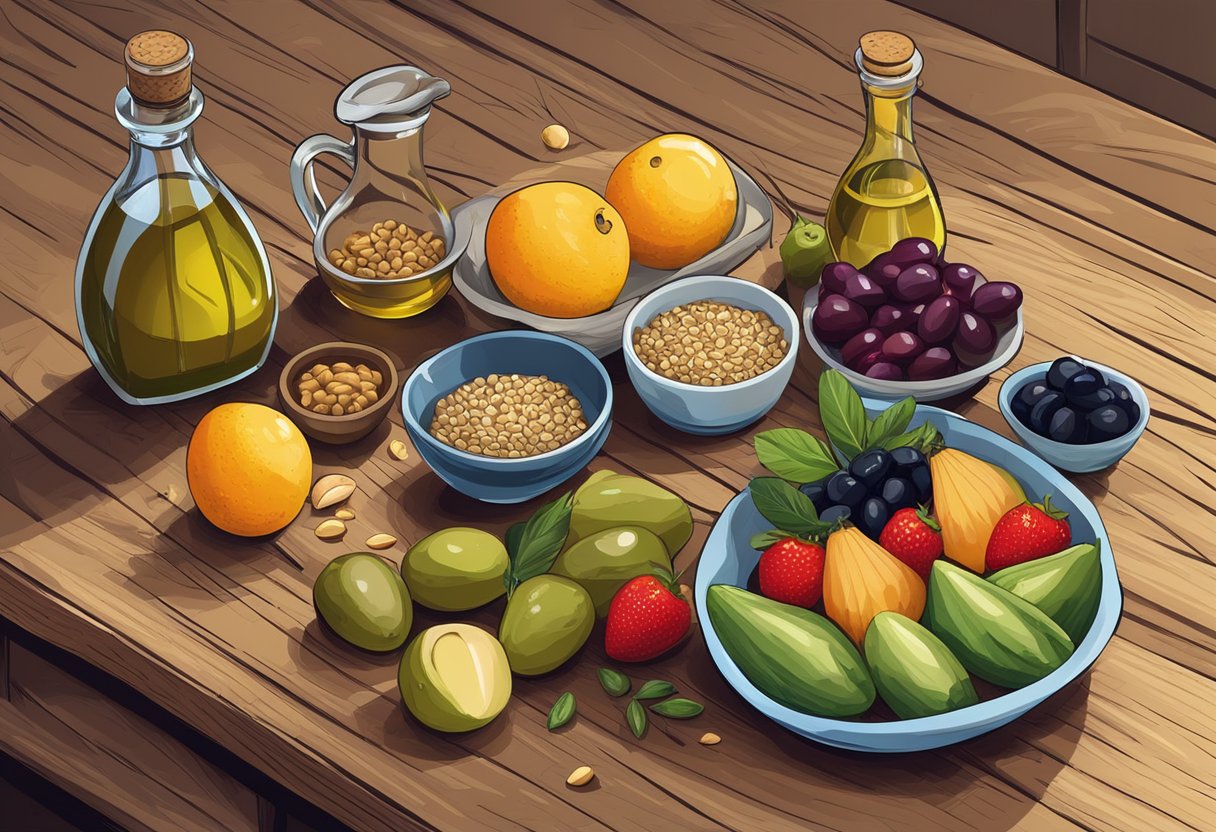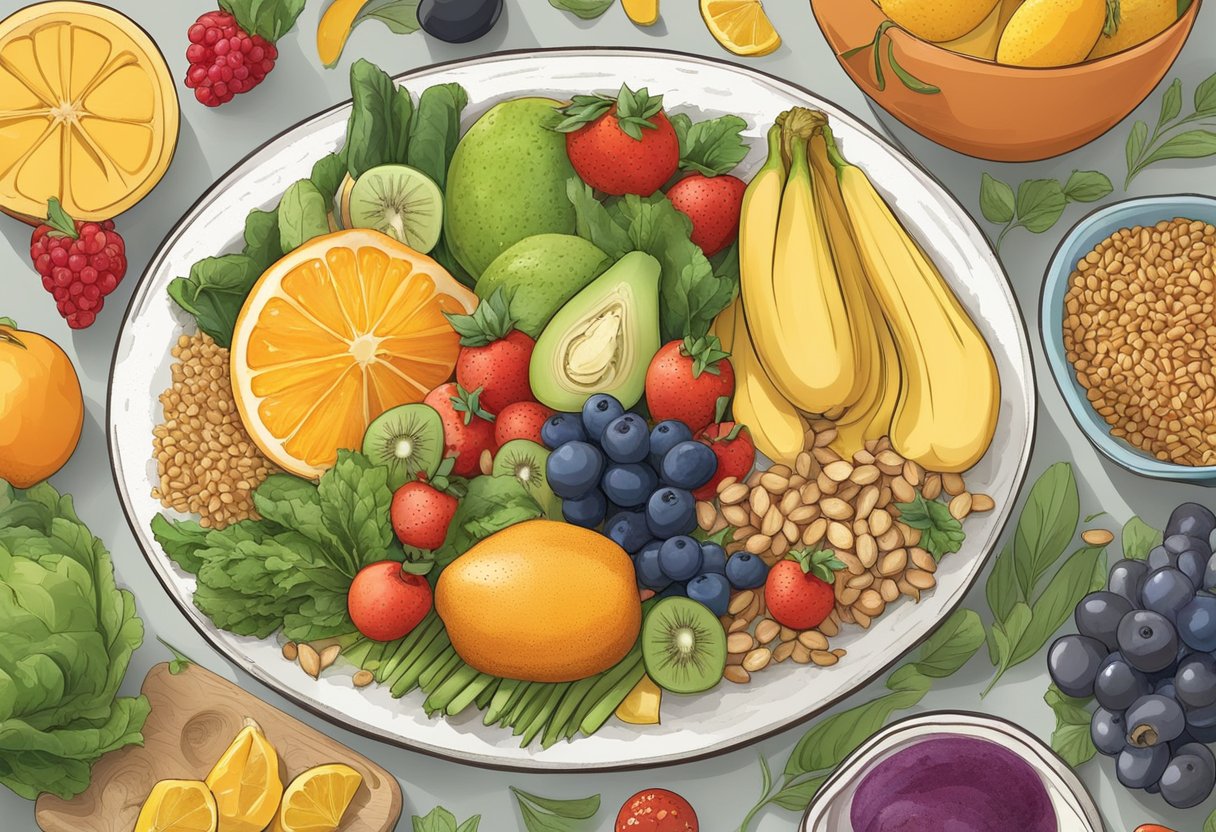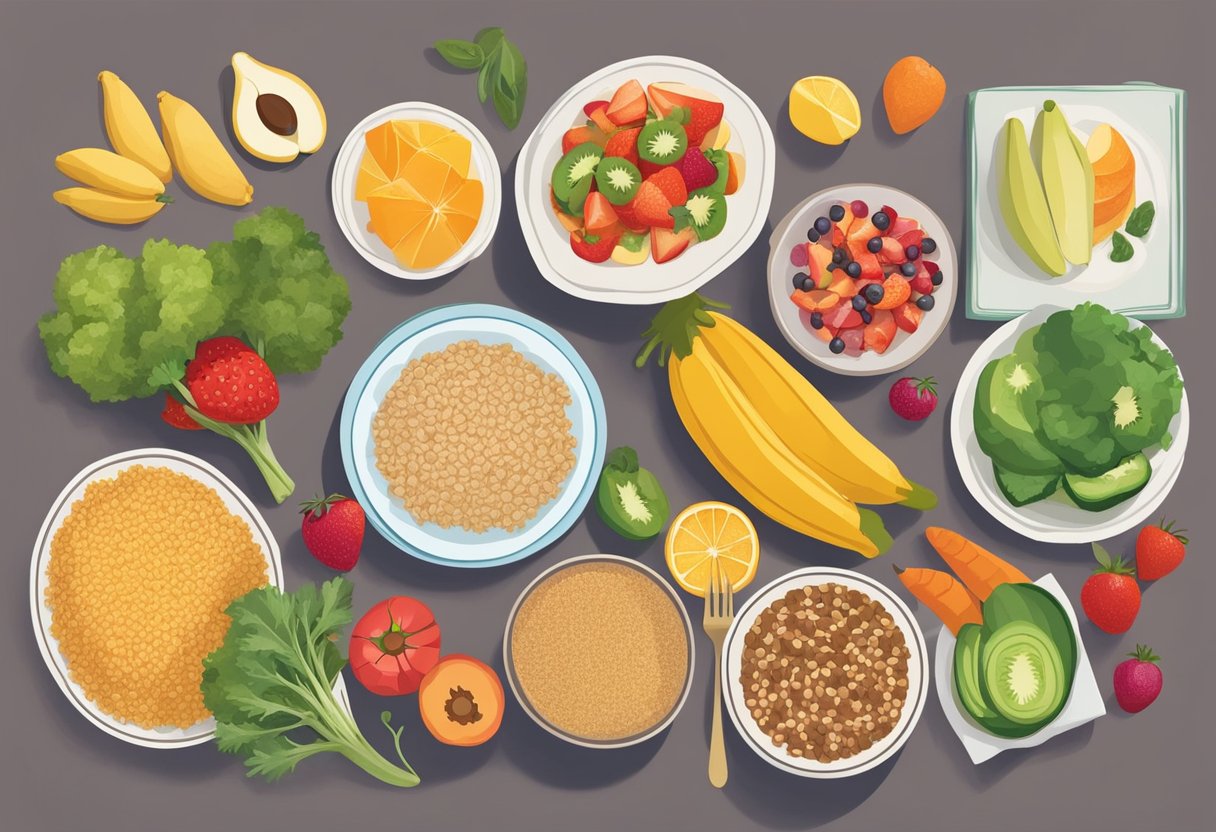Integrating a gluten-free Mediterranean diet into a child’s nutritional regimen offers a unique fusion that can be especially beneficial for kids with celiac disease or non-celiac gluten sensitivity. This approach to eating emphasizes a high intake of fruits, vegetables, whole grains where gluten is not present, legumes, and healthy fats, alongside a moderate consumption of seafood and dairy. It’s designed not only to accommodate the dietary restrictions these conditions necessitate but also to provide the rich variety of nutrients essential for children’s growth and development.

The benefits of a Mediterranean diet have been well-researched and linked with positive health outcomes, including a lower risk of chronic diseases. For children, in particular, adapting this diet to be gluten-free ensures that they avoid ingredients that could trigger adverse reactions, while still enjoying a diet credited with many health advantages. Parents will find that many naturally gluten-free foods, such as quinoa and rice, fit well within the Mediterranean diet framework. Careful meal planning and education about avoiding hidden gluten can help manage a child’s needs without sacrificing the cultural and lifestyle aspects of enjoying diverse, flavorful meals.
Key Takeaways
- A gluten-free Mediterranean diet is a nourishing approach for kids needing a gluten-free regimen.
- Adhering to this diet helps avoid gluten while providing diverse, essential nutrients for children.
- Effective meal planning and gluten avoidance are key to maintaining a healthy, balanced diet for kids.
Table of Contents
Understanding Celiac Disease and Gluten Intolerance
When children are diagnosed with celiac disease or display gluten sensitivity, their diet must change significantly. The focus shifts to avoiding gluten while ensuring they still receive all the necessary nutrients for growth.
The Role of Gluten in Celiac Disease
Gluten is a group of proteins found in certain grains such as wheat, barley, and rye. In celiac disease, consuming gluten triggers an immune response that damages the lining of the small intestine. This damage impairs nutrient absorption and can lead to various health problems. The only effective treatment is a strict gluten-free diet, which stops the damage and allows the intestines to heal.
Identifying Gluten Sensitivity in Children
Gluten sensitivity, while less severe than celiac disease, still causes discomfort and adverse health effects in children. Symptoms can range from bloating and diarrhea to behavioral changes. A gluten-free diet can alleviate these symptoms, but it’s important to receive a proper assessment from a healthcare professional before making dietary changes. Organizations such as the Celiac Disease Foundation offer resources to help families adapt to this dietary requirement.
Basics of the Mediterranean Diet

The Mediterranean Diet emphasizes the consumption of a variety of nutrient-dense foods and the incorporation of healthy fats into one’s daily intake, particularly when adapted to a gluten-free lifestyle, making it suitable for children with specific dietary needs.
Key Foods in the Mediterranean Diet
Whole Grains: Essential staples of the diet, these include gluten-free options such as quinoa, amaranth, and buckwheat.
- Fruit and Vegetables: They form the base of every meal, providing vitamins, minerals, and fiber.
- Legumes and Beans: These offer a good source of protein and fiber.
- Nuts and Seeds: They are a source of healthy fats, protein, and fiber.
- Fish: It’s recommended to have fish at least twice a week due to its Omega-3 fatty acid content.
- Olive Oil: The primary source of added fat, it is used in cooking and dressings.
Note: For a gluten-free adaptation, traditional wheat-based grains should be substituted with gluten-free alternatives.
Benefits of the Mediterranean Diet for Kids
- Rich in Nutrients: Children receive a wide range of essential nutrients necessary for growth and development.
- Heart Health: The diet’s focus on healthy fats, like those found in olive oil, nuts, and fish, contributes to a healthier heart.
Adopting a gluten-free Mediterranean diet ensures children avoid gluten while still benefiting from the diet’s rich variety of foods.
Adapting Mediterranean Diet Principles to a Gluten-Free Lifestyle

The key to adapting the Mediterranean diet for a gluten-free lifestyle is selecting nutrient-rich alternatives to traditional gluten-containing foods while maintaining the diet’s core emphasis on variety and wholesomeness.
Gluten-Free Whole Grains and Alternatives
In a gluten-free approach to the Mediterranean diet, gluten-containing grains like wheat must be replaced with gluten-free whole grains. Staples such as quinoa, rice, and buckwheat offer versatility and nutritional benefits. For example:
- Quinoa: A complete protein
- Brown Rice: Rich in fiber
- Buckwheat: Good for heart health
These grains serve as the foundation for a varied and balanced diet free from gluten.
Incorporating Gluten-Free Protein Sources
Protein is a cornerstone of the Mediterranean diet, and gluten-free options abound. Eggs and dairy provide high-quality protein and are typically included in moderation. Plant-based proteins such as legumes, nuts, and seeds are also integral to this diet, and they do not contain gluten, fitting seamlessly into the gluten-free Mediterranean lifestyle.
Selecting Gluten-Free Fats and Oils
Healthy fats are essential, and olive oil is the primary fat choice in the Mediterranean diet, praised for its heart health benefits. It’s naturally gluten-free and should be used in cooking and dressings. Nuts and seeds are additional sources of gluten-free fats that can be incorporated into daily meals, providing both texture and nutritional value.
Nutritional Considerations for Gluten-Free Kids

When managing a gluten-free diet for children, ensuring proper nutrient intake and preventing inflammation through diet are crucial. Parents and guardians need to focus on incorporating diverse foods that provide essential vitamins and minerals.
Ensuring Adequate Vitamin and Mineral Intake
Children on a gluten-free diet may be at risk for deficiencies in certain vitamins and minerals, necessitating careful dietary planning. A dietitian can guide the inclusion of calcium and iron, which are vital for bone health and preventing anemia, respectively. Fiber is also important for digestive health and can be found in gluten-free whole grains, fruits, and vegetables. Securing enough B vitamins, zinc, and other minerals requires a varied diet that includes foods like legumes, nuts, and seeds. It’s essential for children to consume a balanced diet that aligns with the Mediterranean Gluten-Free Diet, which emphasizes natural, gluten-free foods.
Preventing Inflammation with Diet
The gluten-free Mediterranean diet emphasizes the intake of anti-inflammatory foods. A registered dietitian can help tailor a plan that includes omega-3-rich fish, antioxidants from fruits and vegetables, and healthy fats found in olive oil and nuts. These components are key in promoting healthy eating habits and can reduce inflammation. Balancing the diet with moderate portions of poultry and dairy can further support a child’s nutritional needs without contributing to inflammatory responses.
Meal Planning and Recipes

Incorporating a gluten-free Mediterranean diet into a child’s meal plan ensures they receive a variety of whole foods packed with nutrients while avoiding gluten. This approach focuses on recipes rich in vegetables, fruits, lean proteins, and healthy fats.
Gluten-Free Breakfast Ideas for Kids
Breakfast is an important meal that provides children with energy for the day. Gluten-free breakfast options can be both delicious and nutritious:
- Yogurt Parfait: Layer Greek yogurt with mixed berries and gluten-free granola.
- Omelette: Whisk eggs with diced vegetables and cook in a pan for a protein-rich start.
Each breakfast choice is customizable with a variety of fruits and vegetables to ensure that kids will never get bored.
Healthy Gluten-Free Lunch and Dinner Options
Lunch and dinner on a gluten-free Mediterranean diet are opportunities to integrate diverse whole foods:
- Grilled Salmon: Serve with a side of quinoa salad dressed with lemon and olive oil.
- Falafel Bowls: Homemade falafel served over greens with cucumber, tomatoes, and a gluten-free tahini dressing.
- Gazpacho: Chilled soup made with ripe tomatoes, cucumbers, and bell peppers, perfect for hot days.
These meals incorporate a balance of lean proteins, fresh produce, and healthy fats, adhering to gluten-free requirements while offering flavorful satisfaction.
Lifestyle and Cultural Aspects

Adhering to a gluten-free Mediterranean diet involves more than just food choices—it encompasses a holistic approach that includes physical activity and understanding the cultural heritage that defines this lifestyle.
Incorporating Physical Activity in Kids’ Routines
Physical activity is a cornerstone of the Mediterranean lifestyle, contributing to the higher life expectancy rates observed in countries like Greece, Italy, and Spain. To integrate this element into a child’s routine, daily exercise such as walking, playing outdoor games, or participating in sports should be encouraged. This can be as simple as a family walk after dinner, which aligns with the Mediterranean culture’s emphasis on communal activities and family time.
Understanding the Mediterranean Cultural Background
The cultural background of the Mediterranean Sea region is rich and diverse, influencing the dietary practices of the surrounding countries. When educating children about the gluten-free Mediterranean diet, it’s important to incorporate stories and lessons about the importance of fresh, locally-sourced produce and the tradition of preparing meals with care and attention. These narratives can be powerful in helping them understand why this diet emphasizes plant-based foods, healthy fats like olive oil, and the need for a gluten-free adaptation for those with specific dietary restrictions.
Avoiding Hidden Gluten in Kids’ Diets

When managing a child’s diet, it’s essential to identify and avoid hidden sources of gluten that can sneak into various food products.
Reading Labels for Gluten-Containing Ingredients
Parents should meticulously check food labels for gluten-containing ingredients. Wheat products are often labeled clearly, but gluten can also hide in less obvious ingredients.
- Wheat: Look for any mention of wheat, whole-wheat pastas, and wheat starch.
- Barley: Beware of ingredients like malt syrup, which is derived from barley.
- Rye: Although less common, rye can appear in some cereal and bread products.
Additionally, certain food items like soy sauces, some frozen meals, and granola bars often contain gluten. It is key to read labels for terms like “natural flavoring” or “modified food starch,” which can indicate hidden gluten.
Gluten-Free Alternatives to Familiar Foods
Finding gluten-free options can make it easier to adhere to a strict diet without depriving a child of familiar foods.
- Pasta: Choose gluten-free pastas made from rice, corn, quinoa, or legumes.
- Sauces: Opt for tamari or other gluten-free soy sauces.
- Snacks: Look for certified gluten-free granola bars or make homemade options.
For meat products, it’s vital to confirm they are free from gluten-containing fillers or marinades. Stick to fresh, unprocessed meats when possible and avoid breaded items unless they specifically state they are gluten-free.
Eating Out and Social Considerations

When it comes to children following a gluten-free Mediterranean diet, the challenge often extends beyond the home. Eating out and participating in social events require careful planning and communication to ensure that dietary restrictions are respected and met.
Navigating Restaurants and Social Functions
While dining out, selecting a restaurant that offers gluten-free options is crucial. Parents should look for establishments with clear gluten-free menus or those that highlight the use of whole grains, vegetables, and legumes that fall within the Mediterranean diet framework. It is important to:
- Communicate with the restaurant staff about the child’s gluten-free needs to prevent cross-contamination.
- Review the menu beforehand and consider calling the restaurant to discuss safe options.
- When attending social functions, bringing a gluten-free dish that everyone can enjoy ensures that the child has something safe to eat, while also introducing others to the benefits of the diet.
Educating Friends and Family about Gluten-Free Needs
Education plays a pivotal role in the success of a child’s gluten-free diet, especially within their social circle. Parents should:
- Inform family and friends about what gluten-free entails and why it’s important for their child’s health, referencing the health benefits and dietary guidelines to underscore the importance of adherence.
- Demonstrate easy substitutions for common foods to help them accommodate the child’s diet during gatherings, using examples such as rice or corn-based pastas over traditional wheat options.
By taking the time to educate and prepare, children on a gluten-free Mediterranean diet can enjoy eating out and participating in social events just like their peers, ensuring both their well-being and social inclusion.
Long-Term Health and Wellness

Adopting a gluten-free Mediterranean diet can have profound effects on long-term health for children, from preventing chronic conditions to promoting lifelong healthy eating habits.
Preventing Chronic Conditions
A diet high in vegetables, fruits, and legumes, combined with healthy fats like those found in olives and olive oil, can help stave off chronic conditions such as heart disease and cancer. The emphasis on whole foods and the minimal consumption of red meat align with dietary advice for reducing the risk of these illnesses. This dietary pattern, inherently rich in fiber and antioxidants, supports overall wellness.
- Heart Disease: Frequent consumption of fruits and veggies, and the inclusion of legumes and poultry over red meat, correlates with lower risk markers for heart disease.
- Cancer: A diet low in processed foods and high in natural sources of nutrients is a proactive way to reduce the risk of certain cancers.
Promoting Lifelong Healthy Eating Habits
The Mediterranean diet encourages the enjoyment of meals in a balanced and diverse manner. Foods like fruits, veggies, and whole grains—modified to be gluten-free—are mainstays. Minimized consumption of sweets and red meat alongside a moderate approach to poultry and wine fosters a non-restrictive, varied diet that children can carry into adulthood. This helps them develop an appreciation for a wide array of nutritious foods, laying the foundation for sustained dietary wellness.
- Healthy Fats: Including foods like avocados and nuts, which provide essential fatty acids.
- Fiber: Emphasizing naturally gluten-free grains such as quinoa and buckwheat, alongside fruits and vegetables, supports digestive health, which is crucial for children with conditions like celiac disease.
Support and Resources

Adopting a gluten-free Mediterranean diet for children with celiac disease requires reliable support systems and resources. This section will guide you through avenues to find support and educational material necessary for diet adherence.
Finding Support for Gluten-Free Mediterranean Diet Adherence
Support groups play a critical role in maintaining a gluten-free Mediterranean diet for children. They provide a platform where parents can share experiences, obtain advice, and find camaraderie among those facing similar challenges. The Celiac Disease Foundation offers a comprehensive network for support, including contacts for local and online support groups where families can engage with others on this dietary journey.
Dietitians, especially those registered as experts in celiac disease, can offer personalized guidance. They help in creating meal plans that not only adhere to the strict gluten-free requirements but also incorporate the diverse, nutrient-rich foods characteristic of the Mediterranean diet. Finding a registered dietitian experienced in managing celiac disease is beneficial for ongoing support and ensuring nutritional needs are met.
Educational Resources and Expert Advice
Educational resources are essential for families navigating the gluten-free Mediterranean diet. The Celiac Disease Foundation provides a wealth of information, including a 7-Day Gluten-Free Mediterranean Diet Meal Plan, which can help parents jumpstart their meal planning with confidence.
Expert advice is invaluable for understanding the nuances of managing celiac disease through diet. Websites like BeyondCeliac.org offer guides that are tailored for children, ensuring that they receive the nutrients they need while adhering to a gluten-free lifestyle. These resources often break down complex information into actionable steps for caregivers, simplifying the process of dietary management.
Conclusion

Adopting a gluten-free Mediterranean diet benefits children in numerous ways. Children with celiac disease require a strict gluten-free diet to maintain their health, and this dietary pattern successfully integrates vital nutrients that typical gluten-free diets may lack. The combination of these two diets provides a rich array of fruits, vegetables, lean proteins, and healthy fats while avoiding gluten-containing grains.
Parents can rest assured that a gluten-free Mediterranean diet not only supports the nutritional needs of their kids but also contributes to an overall anti-inflammatory effect within the body. Such a diet encourages the consumption of:
- Whole, naturally gluten-free grains like quinoa and rice
- A variety of fruits and vegetables
- Quality protein sources such as fish and poultry
- Legumes and nuts
Moreover, it emphasizes the importance of preparing wholesome meals that can become enjoyable family activities. By inculcating these eating habits early, parents can help their children establish a lifelong foundation of nutritious choices that can prevent chronic diseases and support a healthy weight.
In essence, for kids with celiac disease or gluten sensitivity, the gluten-free Mediterranean diet is not only a necessity but a pathway to robust health and vitality. It’s a sustainable choice that aligns with a lifestyle promoting physical well-being and disease prevention.
Frequently Asked Questions

This section provides concise answers to common queries regarding a gluten-free Mediterranean diet tailored for children.
What are some kid-friendly gluten-free Mediterranean diet recipes?
A variety of recipes are perfectly suited for kids, such as gluten-free pasta salads, grilled chicken skewers, and roasted vegetable dishes. The Celiac Disease Foundation offers meal plans and recipes that combine the appeal of Mediterranean flavors with the safety of a gluten-free diet.
How can I adapt a gluten-free Mediterranean diet meal plan for a child?
Adapting a meal plan involves incorporating nutritious, naturally gluten-free grains like quinoa and rice, adding colorful fruits and vegetables, and including lean proteins. Creating enjoyable and diverse meal options can make the Mediterranean diet more appealing for a child.
Where can I find a comprehensive shopping list for a gluten-free Mediterranean diet?
Comprehensive shopping lists for a gluten-free Mediterranean diet can be found at resources like Beyond Celiac, which also provides guidance on safe food selection for children with celiac disease.
What are the best gluten-free Mediterranean cookbooks that are suitable for children’s meals?
There are cookbooks designed specifically for gluten-free Mediterranean cooking, such as those that offer recipes for family-friendly dishes that are both nourishing and palatable for children’s taste preferences.
Can children with celiac disease benefit from a gluten-free Mediterranean diet?
Children with celiac disease can benefit significantly from a gluten-free Mediterranean diet as it emphasizes whole foods and minimizes processed items, which is essential for their healing and overall well-being. The diet can help in managing symptoms and promoting intestinal healing when followed strictly.
How do I include a variety of breakfast options in my child’s gluten-free Mediterranean diet?
Include a variety of breakfast options by using gluten-free cereals made from rice or corn, preparing omelets with fresh vegetables, and offering yogurt topped with gluten-free granola and fruit. These choices provide a balance of protein, fiber, and vitamins to start the day.



